At Bow Cemetery
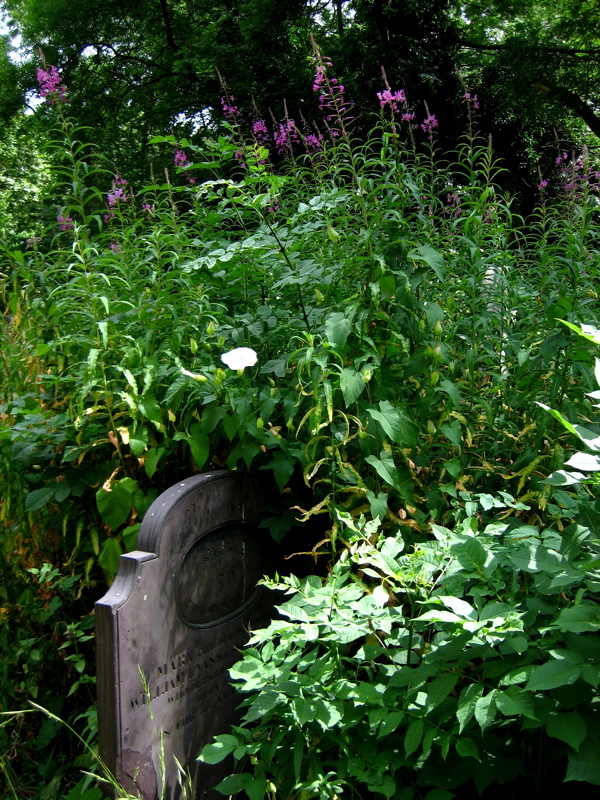
At least once each Summer, I direct my steps eastwards from Spitalfields along the Mile End Rd towards Bow Cemetery, one of the “Magnificent Seven” created by act of Parliament in 1832 as the growing population of London overcrowded the small parish churchyards. Extending to twenty-seven acres and planned on an industrial scale, “The City of London and Tower Hamlets Cemetery” as it was formally called, opened in 1841 and within the first half century alone around a quarter of a million were buried here.
Although it is the tombstones and monuments that present a striking display today, most of the occupants of this cemetery were residents of the East End whose families could not afford a funeral or a plot. They were buried in mass public graves containing as many as forty bodies of random souls interred together for eternity. By the end of the nineteenth century the site was already overgrown, though burials continued until it was closed in 1966.
Where death once held dominion, nature has reclaimed the territory and a magnificent broadleaf forest has grown, bringing luxuriant growth that is alive with wildlife. Now the tombstones and monuments stand among leaf mould in deep woods, garlanded with ivy and surrounded by wildflowers. Tombstones and undergrowth make one of the most lyrical contrasts I can think of – there is a beautiful aesthetic manifest in the grim austerity of the stones ameliorated by vigorous plant life. But more than this, to see the symbols of death physically overwhelmed by extravagant new growth touches the human spirit. It is both humbling and uplifting at the same time. It is the triumph of life. Nature has returned and brought more than sixteen species of butterflies with her.
This is the emotive spectacle that leads me here, turning right at Mile End tube station and hurrying down Southern Grove, increasing my pace with rising expectation, until I walk through the cemetery gates and I am transported into the green world that awaits. At once, I turn right into Sanctuary Wood, stepping off the track to walk into a tall stand of ivy-clad sycamores, upon a carpet of leaves that is shaded by the forest canopy more than twenty metres overhead and illuminated by narrow shafts of sunlight descending. It is sublime. Come here to see the bluebells in Spring or the foxgloves in Summer. Come at any time of the year to find yourself in another landscape. Just like the forest in Richard Jefferies’ novel “After London,” the trees have regrown to remind us what this land was once like, long ago before our predecessors ever came here.
Over time, the tombstones have weathered and worn, and some have turned green, entirely harmonious with their overgrown environment, as if they sprouted and grew like toadstools. The natural stillness of the forest possesses greater resonance between cemetery walls and the deep green shadows of the woodland seem deeper too. There was almost no-one alive to be seen on the morning of my visit, apart from two police officers on horseback passing through, keeping the peace that is as deep as the grave.
Just as time mediates grief and grants us perspective, nature also encompasses the dead, enfolding them all, as it has done here in a green forest. These are the people who made East London, who laid the roads, built the houses and created the foundations of the city we inhabit. The countless thousands who were here before us, walking the streets we know, attending the same schools, even living in some of the same houses we live in today. The majority of those people are here now in Bow Cemetery. As you walk around, names catch your eye, Cornelius aged just two years, or Eliza or Louise or Emma, or Caleb who enjoyed a happy life, all over a hundred years ago. None ever dreamed a forest would grow over their head, where people would come to walk one day to discover their stones in a woodland glade. It is a vision of paradise above, fulfilled within the confines of the cemetery itself.
As I made my progress through the forest of tombstones, I heard a mysterious noise, a click-clack echoing through the trees. Then I came upon a clearing at the very heart of the cemetery and discovered the origin of the sound. It was a solitary juggler practicing his art among the graves, in a patch of sunlight. There is no purpose to juggling than that of delight, the attunement of human reflexes to create a joyful effect. It was a startling image to discover, and seeing it here in the deep woods – where so many fellow Londoners are buried – made my heart leap. Outside on the streets, a million people were going about their business while in the vast wooded cemetery there was just me, the numberless dead and the juggler.
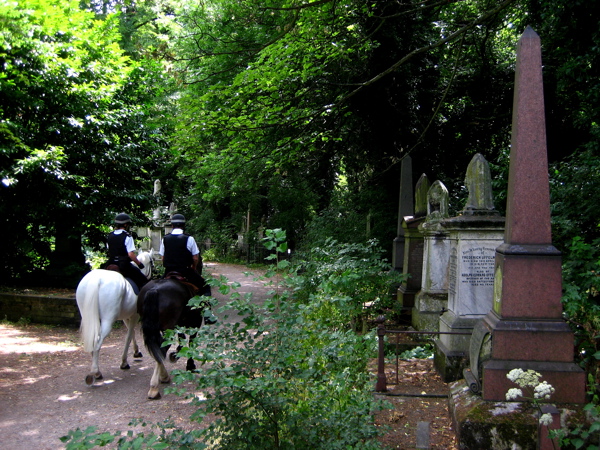

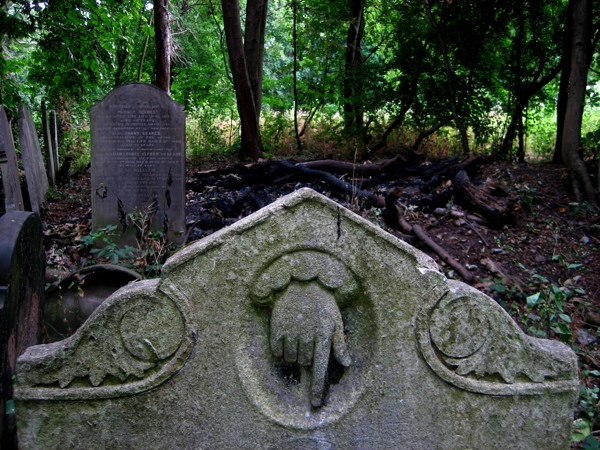
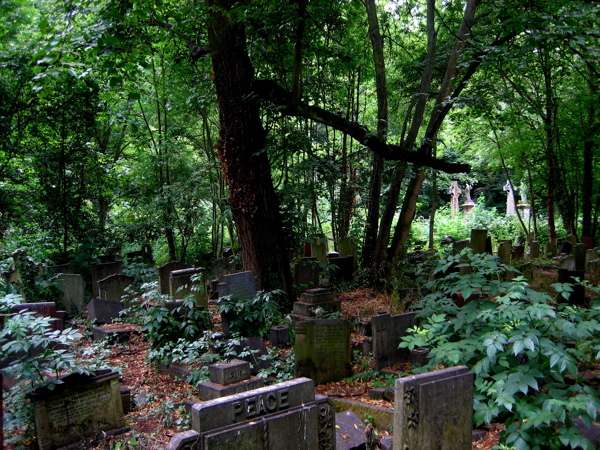

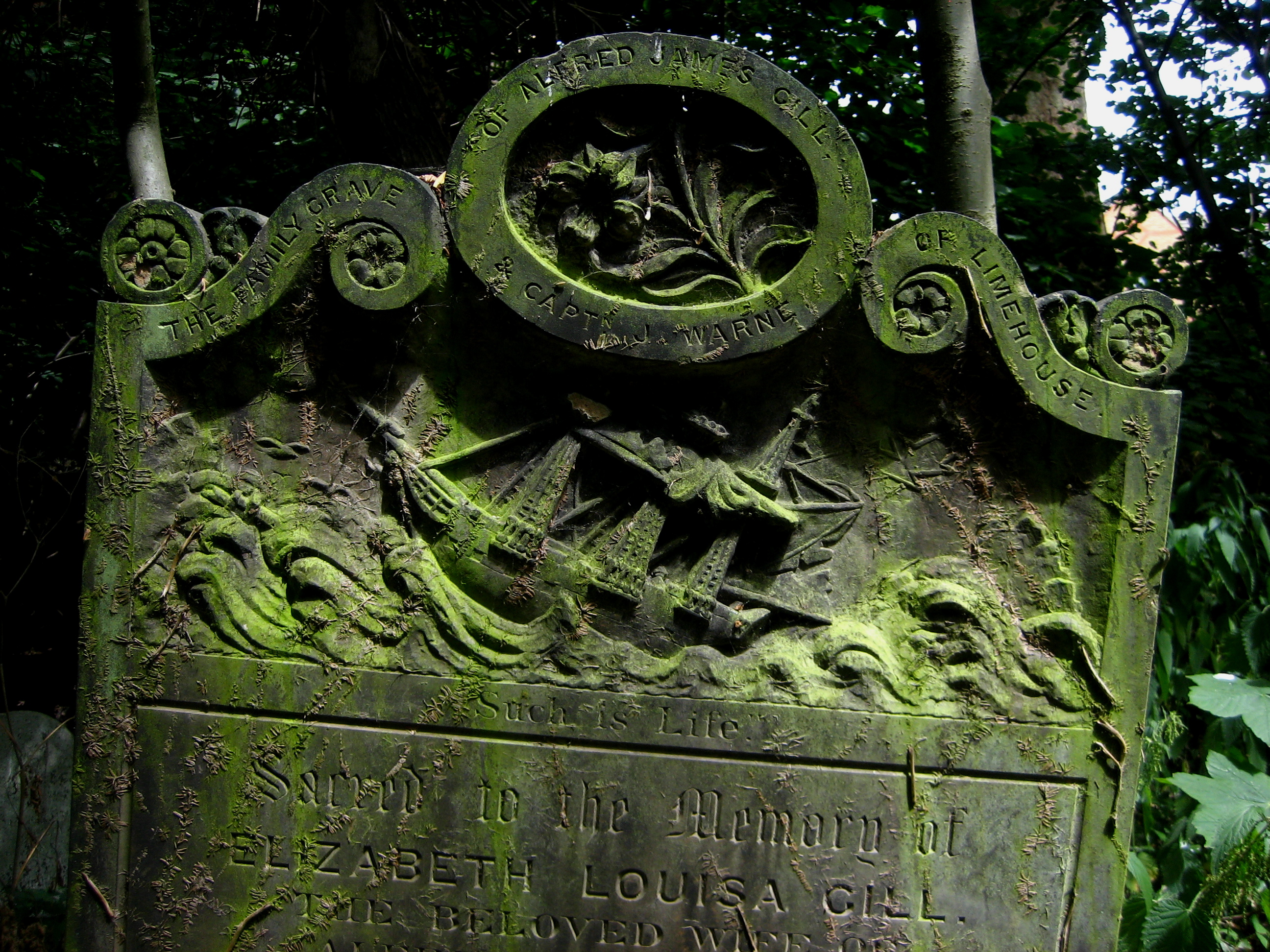

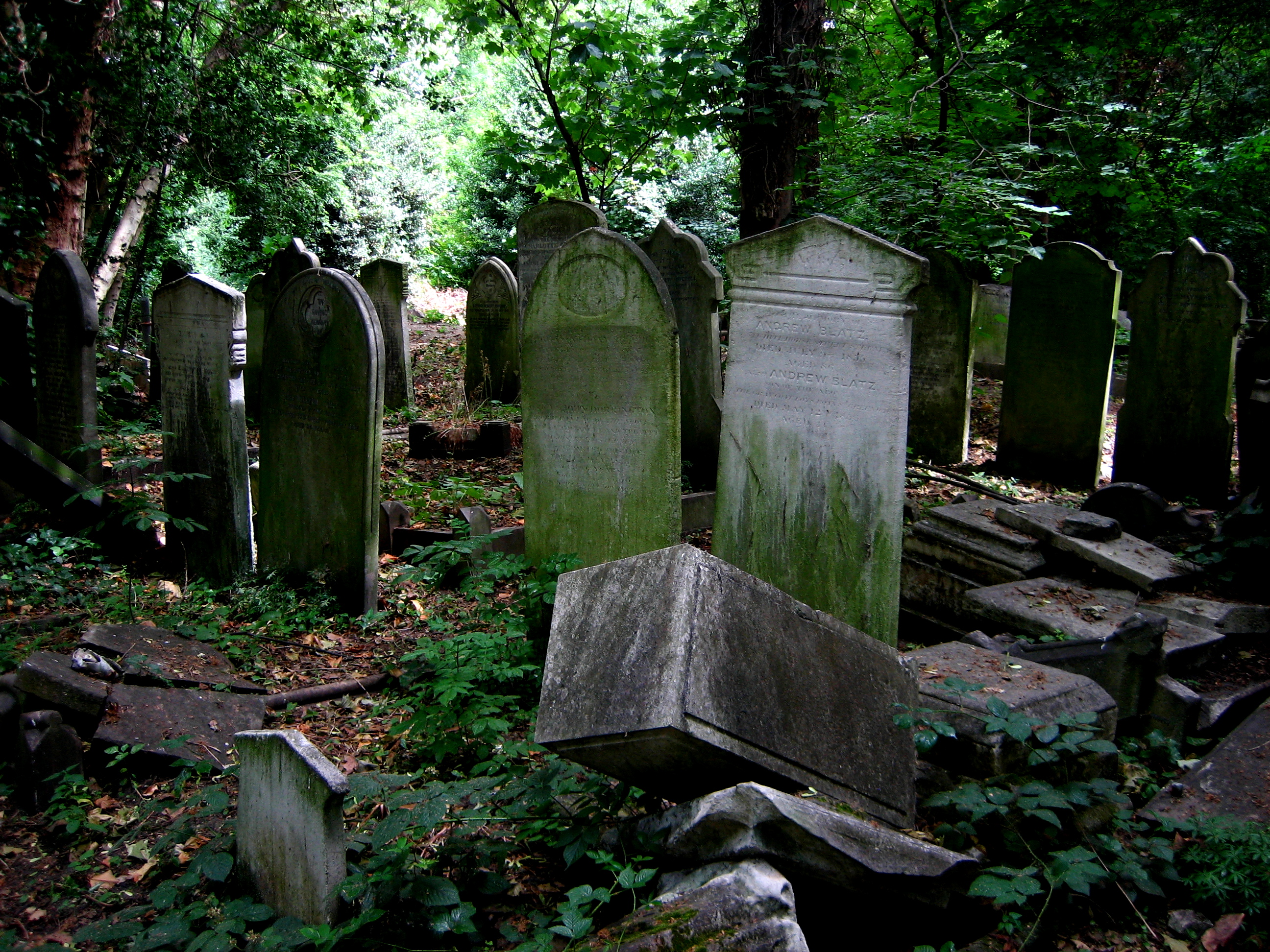
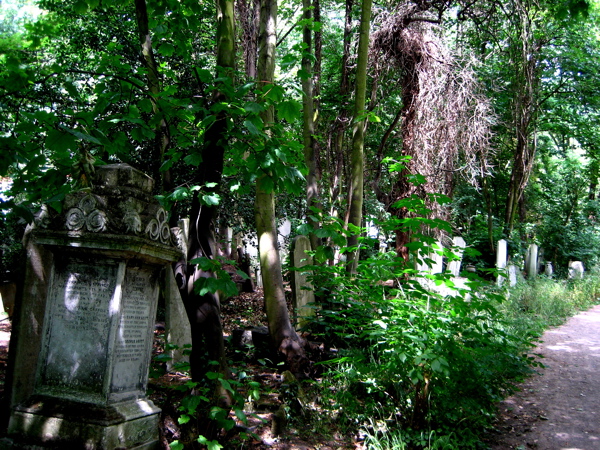
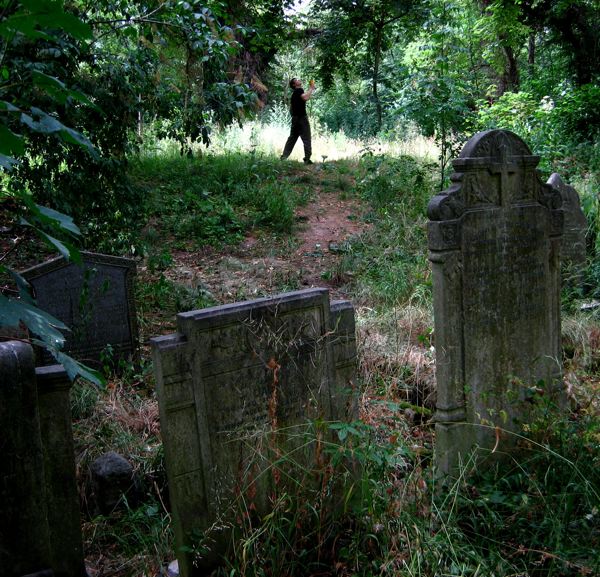
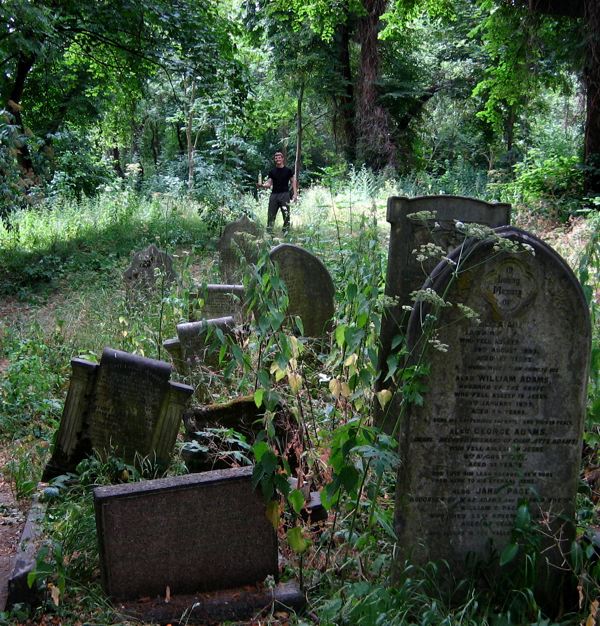
Find out more at www.towerhamletscemetery.org

















Another very moving post. I marvel at how you do manage to choose truly unique subjects for these post. The very living and those who merit the attention of the very living.
The photographs are splendid.
This, gentle author, is an awesome post. Thank you!
What a magical encounter.
Still called Tower Hamlets Cemetery by those of us who live round here, it’s also
* part of the Tower Hamlets Park Conservation Area
* a designated green space called Tower Hamlets Cemetery Park
* run by the The Friends of Tower Hamlets Cemetery Park – who were set up in 1990 to help preserve the Cemetary and the heritage and green space that it represents.
Tower Hamlets Cemetery Park is owned by the London Borough of Tower Hamlets (LBTH).
The ‘Friends’ manage the Cemetery Park via a Service Level Agreement with LBTH Parks.
Long may this arrangement continue.
What we can now enjoy is very largely down to the efforts of the Friends who have dedicated themselves to this very important green space in Tower Hamlets.
As old and established as London appears to be, we are reminded that nothing is forever.The cycle of life continues to roll on and that can be a very beautiful thing. It’s all about rebirth and renewall.
There is a life-lesson to be learned from that.
Dearest Gentle Writer:
I came across your blog recently whilst doing research on my ancestors who dwelt for many generations in Spitalfields and close-by environs. I’m driven by a desire to know these people–not as a collection of random names and dates on a paper–but to know how they lived, worked and had their being. While I realize that time and way of life is long gone, the container of the place that held them remains, and so must their essence have infused it deeply.
From where I sit, many thousands of miles distant across the pond, there is a delicious sense of being able to glimpse through a magical lens into the world of Spitalfields through your blog. It’s magical because I can never predict what will swim into view through that lens: an ancient Synagogue, the shockingly blue face of a cornflower, or a flotilla of grave stones bobbing on an emerald sea.
No matter the subject, you treat it with such reverence and care that each post is like having a treasure quietly revealed–the perfect blend of sacredness and lusciousness!
Count me addicted…
Your thrilled & humble reader,
–B
What an atmospheric place. I’m loath to say that i love graveyards but i do and was in one in Manchester only last week .
i believe my ancesters are buried here in 1946 a richard samuel peacham can anyone seek him out for me
jackie
I have recent relatives buried here (and probably a whole load of not so recent relatives).
My Jones’s were buried here between 1929 and 1939. Poor Ethel died of TB aged just 19.
Until 2001 we lived in Eric Street Mile End, a short walk from the cemetary. I used to take my son for a walk in his pram there. It was very peaceful.
Now, doing my family history, I wish I’d looked more closely at the names on the gravestones.
Lesley
I am English and grew up in Bethnal Green but now live in Melbourne, Australia. I visited the ‘Boneyard’ (as it was affectionately known), a few years ago when visiting my brother and his family who lived in Eric St, Bow, just across the road. It was strangely beautiful and I’ve never forgotten it but your post brought it vividly back to life. Thank you.
After all these years my heart is still in England and her wonderful history. You can take the cockney out of London, but you can’t take London out of the cockney. 🙂 Thanks for the memories and please keep up the good work.
i used to live near the mount zion slave cemetery in washington d.c. where thousands of people who built the city were buried. the snowdrops reminded me of this.
http://www.ipernity.com/doc/elvertbarnes/album/193893
beautiful piece, thank you.
My Great Grandfather is buried here, it is a lovely and peaceful place.
I visited the cemetery today. Primroses, violets, wood anemones and even cowslips were lovely. Birds singing, robins, tits and wrens chirping but no parakeets as I saw and heard on a previous visit
However major renovation seems to be occuring – large areas being cleared, including whole tree chopping. Some parts have lost their magical charm. Obviously nature will fight back but the devastation seems very drastic. Is this part of ‘The Friends’ plans?
beautiful…thankyou GA..
This cemetery has a special charm and beauty. I’ve seen the “Friends” work and it looks very tidy and clean. Thank you all so much for all the hard work
what wonderful pictures and insightful commentary. Old Church yards are such havens of peace -and I remember hearing birdsong in them when I used to visit some of them when at school.I am now living in a countryside spot, but those London Church yard birds of long ago(I am 75) still remain in my head!
Thank you for all the photos and commentaries by “Gentle Author”
I lived in Boise, Idaho for about a year during the first Gulf War. To try to come to grips with war, even a war I experienced solely through a tiny black and white television set, I often walked in the Morris Hill cemetary, looking at the gravestones – from the recent ceremonial graves of veterans, to the haunting stones of infants, to some marked only with a single name and a date of death.
One day, as I stood looking at a row of tree-root tilted stones near Roosevelt Street, all marked ‘Archer,’ – father, died age approximately 55, mother, died age about 68, child 4, child 18 months, and six unnamed infants, none of whom had lived more than a few days – and wondering how the parents could have gone on living after losing so much – an old man came up to me, apparently having seen me from across the street. He might have been in his 90s, no longer spry, but not needing a walker quite yet. He said, “Would you like to know about this family? This is my family.”
He told me that he was one of three surviving children, out of eleven, and that he and his siblings were all still alive. He said that the four year old died of eating apples sprayed with arsenic to keep off insects; the 18 month old drowned in a ditch, and the infants just died. He told me his family once owned a huge orchard (for which Orchard street is named), but that over the years the trees had all been cut down but one, and that he still lived in the original family home, which was at the time an old 2-story white farmhouse, out of place among its more modern neighbors.
Before I moved away, I saw an ambulance in front of the old Archer home, and I wonder if he joined his family at rest. If you ever go to Boise, find them there. He entrusted me with his story. I would hate to see it lost.
Just wondering how many of my relatives from Limehouse & Isle Of Dogs are buried there…
My relatives came from Spitalfields – Harper and Walker : and from Bow/Bromley – Hunt, Sharman and Waldon. Anybody with any connection to these names? We moved to Forest Gate/East Ham (now unfortunately known as “Newham”) in the fifties.
Barbara in Hampshire
So characterful thankyou.
I am studying my family history and am looking for William Cook interred Bow Cemetary in 1870. Can any one point me in the right direction to see if there is an index of gravestones please?
Melanie, you can find it at the Metropolitan archives I think. Also Bancroft road E1. There is archive centre.
Visited the UK from Australia to find family Helmcken. My 5 X great grandmother, Catherine Helmcken, was buried 11 Feb 1869 in this cemetery but sadly no headstone was found. The picture you painted was beautiful of this cemetery and gave me a lovely image to recall.
Thank you.
Patch
My grandmother is buried at Bow cemetery, her maiden name was Frances Coker, I would love to find the grave as she died before I was born in 1941. I was told don’t go alone as it’s quite a dodgy place and you could get mugged.
A wonderful, lyrical and deeply moving post – and excellently written too.
Hello, I have a cousin buried in Bow Cemetery, his name was Joseph Shepherd Guy. He was buried on 2nd Nov 1871 aged 25, he died of small pox.
If anyone out there knows where he is buried please let me know?
it looks a very interesting place but I cannot visit.
S Hawley
thank you if any one no any thing to let me no please x
Dear Gentle Author,
It touched my heart to see these long lost churchards/graveyards. My great gran and grandad are burriwd in Mile End Cemetary and a great aunt who died of the influensia,pls excuse spelling I would love to find their graves. Harry and Harriet Smith .
Thank you
Lesley
I have a number of relatives buried here – mostly in unmarked graves – and visited last summer to pay my respects. The ‘Friends’ (volunteers) were so helpful and friendly. It’s a beautiful place. An excellent article. Thank you Gentle Author.
My father told me that my grand parents are buried here, there name was Charles Robert Tiller and Florence Tiller in the mid 1930s that’s all I know, I would love to know, if anyone can find out for me I will pay them £100.
My 3rd great grandmother and her mother in law, my 4th great grandmother were buried there. 3rd died at sea after giving birth to her only son. We only just found the record confirming her burial, we had previously thought she had been buried at sea. Hopefully when Covid subsides, my family and I can come and find them. Love from Atlanta, Georgia, USA!
Thank you for your lovely article perhaps I will make it there one day. I believe my 3x great grandfather might be buried there, he took his own life in 1854 whilst living in Bow so this seems the most likely place. Unfortunately I’m sure it would have been a common grave so no chance of find it. Thank you Lesley
Following on from my previous message…Of course, I have just realised that as a suicide my ancestor would not have been buried in any cemetery. Does anyone have any idea where they might have buried him in the Bow area? Lesley
I beleave my granddad is buried in Bow cemetery died just after 2 word war his name was fredrick vowles age 48 can any one find him thank you
My family lived in Bow from at least the early 1700s up to 1990s …how can I find the niederman graves?
My great grand father, Frank Ernest Lee was born in Bow, in 1874. He was one of 17 siblings of varying ages. At any one time there were only 6 children. The other 11 children, from the age of 7 years to 2 weeks old, all died young, and are all buried in the Bow Cemetery. Is there a register of burials at the Bow cemetery, to confirm they are all buried there?
Incidentally, Frank Ernest Lee moved to South Africa ,to fight in The Boar war in 1899, live in S.A until his death in 1947, and is buried in East London, South Africa.
Many Thanks from Nelspruit, South Africa.
Peter Fetting.